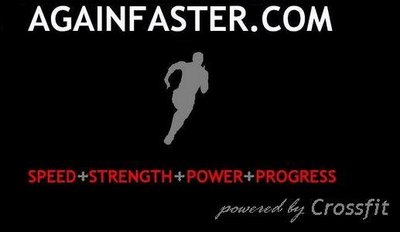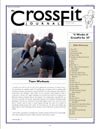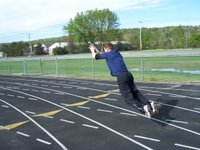Push

Strength in the shoulder girdle is essential for good performance in the Olympic lifts and their components. The deadlift, overhead squat, and overhead presses hold the key to developing good shoulder girdle strength.
The Olympic lifts are the Snatch and the Clean and Jerk. Why are you laughing? It’s not funny. It's not. What are you, twelve? Try and stay with me.
Both lifts involve getting a ton of weight over your head very quickly. The snatch is a single movement, bringing a barbell from the floor to a deep overhead squat to standing.
The clean and jerk is a two-part movement. The athlete cleans the barbell to their chest, resets grip, and explodes the weight overhead.
Both of these lifts are technically difficult, the snatch more so. The movement is unnatural without extensive practice. For this reason, we don’t send beginners up to the bar with the instruction “Okay, snatch it.” First, the athlete learns the components of the lifts. These are:
Bodyweight squat
Deadlift
Press
Push Press
Push Jerk
Front squat
Overhead squat
The snatch could be described as a wide-grip deadlift to an overhead squat, while the C&J is a deadlift to a front squat to a push jerk.
Learning the components of the O-lifts gives the athlete all of the tools he/she needs for successful performance. You should be familiar with proper squat and deadlift form by now, even if you haven’t mastered these movements.
The deadlift movement ends when the athlete is at extension, with the shoulder girdle entirely retracted and the chest held high. Moving significant weight requires strength throughout the back and shoulders to achieve this retraction.
Similarly, the overhead squat requires a ton of shoulder and back strength, as the athlete fights to keep the weight directly overhead with shoulders shrugged.
Developing shoulder strength through the press, push press, and push jerk leaves the athlete with the strength to deadlift and overhead squat. The presses also provide technical skills that transfer easily to the Olympic movements.
Note that each press should require less absolute strength than the next. The press is harder than the push press; the push press is harder than the push jerk. For this reason, the presses are often performed in sequence. As the athlete becomes more and more fatigued, he/she is presented with a press that requires a little less strength.
The press is the hardest of the presses because the athlete must put the weight overhead using only his/her torso, back, and shoulder strength. The legs are not used to impart momentum on the bar. The athlete racks the weight to the shoulders, with the elbows facing straight down and the forearms parallel to the body. Then he puts the weight up to full extension overhead.
The push press allows the athlete to use his legs to create momentum and elevation on the bar. He goes into a quarter-squat with the bar in the same rack position described above.

By pushing through the heels and exhibiting powerful hip extension, the athlete puts momentum on the bar, creating momentary weightlessness as he pushes up violently. The leg/hip extension moves the weight through the most difficult portion of the pressing movement—the first few inches—putting the athlete in a more advantageous position to complete the lift with his back, shoulders, and arms.
The push jerk is very similar to the push press, but instead of trying to push the weight to extension with the feet firmly planted, the athlete drops under the bar after creating initial momentum.
He lands in a semi-squat, arms fully extended at the same moment his feet meet the ground. Then, the athlete simply stands up, completing the push jerk. The push jerk is the same movement that ends the clean and jerk, albeit with the feet side-by-side instead of split.
The three-press sequence gives the athlete several advantages. It allows the athlete to keep training the pressing movement with the same or higher weight as fatigue sets in. This builds significant strength in the back and shoulder girdle, giving the athlete the basic building blocks of a successful overhead squat.
In addition, the three press progression is great practice for the clean and jerk--both exercises end in the same movement.
The presses can be done with a barbell, kettlebells, or dumbells. Dumbbells and kettlebells give the athlete the option of performing one-armed presses, which confer additional benefits in the form of rotational stability and strength.
Give this a shot: 3 sets of 3 reps for each press (3 x 3)
Press
Push Press
Push Jerk
I first did this rep scheme at Crossfit Boston under the tutelage of Neal Thompson.
Also, try your hand at some one-armed presses. The one-armed split jerk is sure to attract some attention at the gym, whether you want it or not. If you’d like to incorporate these movements into your metabolic workouts, lower the weight and up the reps.
Try this: 5 rounds for time
15 burpees
20 split jerks (10L, 10R) w/ 40# DB
Let me know how it goes. You can always reach me by clicking the “Contact Again Faster” link in the right-hand sidebar. I answer all of these emails personally. If you have a question or comment you’d rather not post, this is a great option for getting in touch.
Go faster!

Strength in the shoulder girdle is essential for good performance in the Olympic lifts and their components. The deadlift, overhead squat, and overhead presses hold the key to developing good shoulder girdle strength.
The Olympic lifts are the Snatch and the Clean and Jerk. Why are you laughing? It’s not funny. It's not. What are you, twelve? Try and stay with me.
Both lifts involve getting a ton of weight over your head very quickly. The snatch is a single movement, bringing a barbell from the floor to a deep overhead squat to standing.
The clean and jerk is a two-part movement. The athlete cleans the barbell to their chest, resets grip, and explodes the weight overhead.
Both of these lifts are technically difficult, the snatch more so. The movement is unnatural without extensive practice. For this reason, we don’t send beginners up to the bar with the instruction “Okay, snatch it.” First, the athlete learns the components of the lifts. These are:
Bodyweight squat
Deadlift
Press
Push Press
Push Jerk
Front squat
Overhead squat
The snatch could be described as a wide-grip deadlift to an overhead squat, while the C&J is a deadlift to a front squat to a push jerk.
Learning the components of the O-lifts gives the athlete all of the tools he/she needs for successful performance. You should be familiar with proper squat and deadlift form by now, even if you haven’t mastered these movements.
The deadlift movement ends when the athlete is at extension, with the shoulder girdle entirely retracted and the chest held high. Moving significant weight requires strength throughout the back and shoulders to achieve this retraction.
Similarly, the overhead squat requires a ton of shoulder and back strength, as the athlete fights to keep the weight directly overhead with shoulders shrugged.
Developing shoulder strength through the press, push press, and push jerk leaves the athlete with the strength to deadlift and overhead squat. The presses also provide technical skills that transfer easily to the Olympic movements.
Note that each press should require less absolute strength than the next. The press is harder than the push press; the push press is harder than the push jerk. For this reason, the presses are often performed in sequence. As the athlete becomes more and more fatigued, he/she is presented with a press that requires a little less strength.
The press is the hardest of the presses because the athlete must put the weight overhead using only his/her torso, back, and shoulder strength. The legs are not used to impart momentum on the bar. The athlete racks the weight to the shoulders, with the elbows facing straight down and the forearms parallel to the body. Then he puts the weight up to full extension overhead.
The push press allows the athlete to use his legs to create momentum and elevation on the bar. He goes into a quarter-squat with the bar in the same rack position described above.

By pushing through the heels and exhibiting powerful hip extension, the athlete puts momentum on the bar, creating momentary weightlessness as he pushes up violently. The leg/hip extension moves the weight through the most difficult portion of the pressing movement—the first few inches—putting the athlete in a more advantageous position to complete the lift with his back, shoulders, and arms.
The push jerk is very similar to the push press, but instead of trying to push the weight to extension with the feet firmly planted, the athlete drops under the bar after creating initial momentum.
He lands in a semi-squat, arms fully extended at the same moment his feet meet the ground. Then, the athlete simply stands up, completing the push jerk. The push jerk is the same movement that ends the clean and jerk, albeit with the feet side-by-side instead of split.
The three-press sequence gives the athlete several advantages. It allows the athlete to keep training the pressing movement with the same or higher weight as fatigue sets in. This builds significant strength in the back and shoulder girdle, giving the athlete the basic building blocks of a successful overhead squat.
In addition, the three press progression is great practice for the clean and jerk--both exercises end in the same movement.
The presses can be done with a barbell, kettlebells, or dumbells. Dumbbells and kettlebells give the athlete the option of performing one-armed presses, which confer additional benefits in the form of rotational stability and strength.
Give this a shot: 3 sets of 3 reps for each press (3 x 3)
Press
Push Press
Push Jerk
I first did this rep scheme at Crossfit Boston under the tutelage of Neal Thompson.
Also, try your hand at some one-armed presses. The one-armed split jerk is sure to attract some attention at the gym, whether you want it or not. If you’d like to incorporate these movements into your metabolic workouts, lower the weight and up the reps.
Try this: 5 rounds for time
15 burpees
20 split jerks (10L, 10R) w/ 40# DB
Let me know how it goes. You can always reach me by clicking the “Contact Again Faster” link in the right-hand sidebar. I answer all of these emails personally. If you have a question or comment you’d rather not post, this is a great option for getting in touch.
Go faster!




















3 Comments:
Hehe,
You wrote snatch, dude. Hehe.
I guess I opened the door for that one...
hey jon - continuing on our discussion this am... check out
http://www.performancemenu.com/
some good stuff there.... more focused on nutrition/homronal responses. anyway, you can download a free issue of the journal and the most recent issue has a good article on stretching.
i hope you feel better soon!
Post a Comment
<< Home